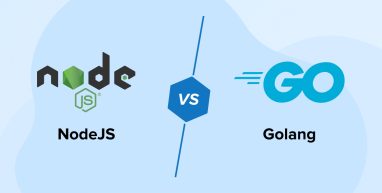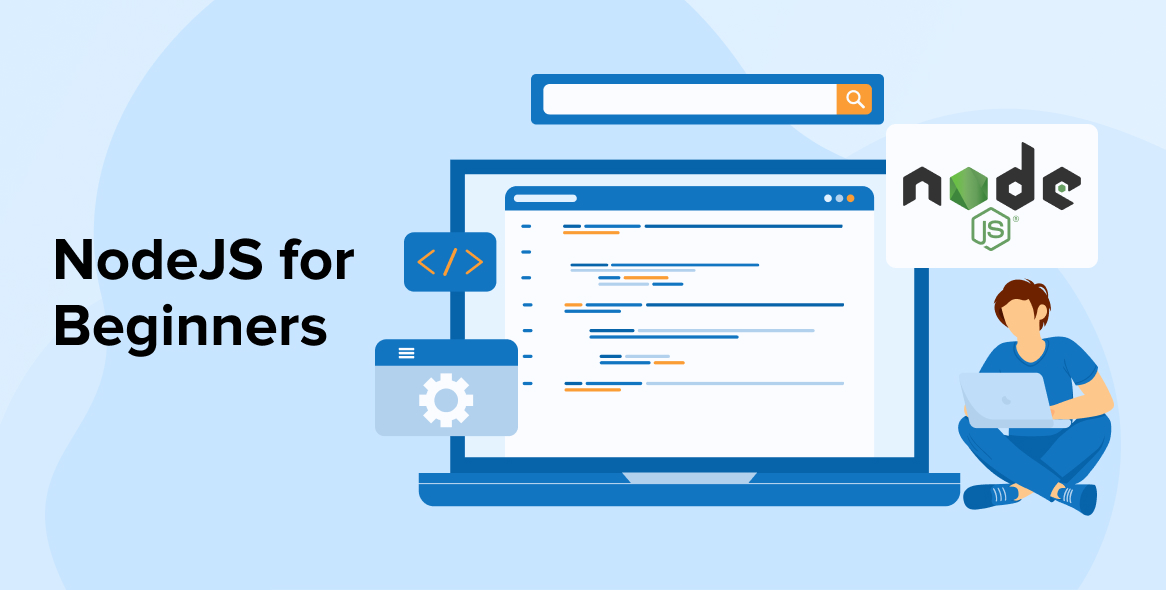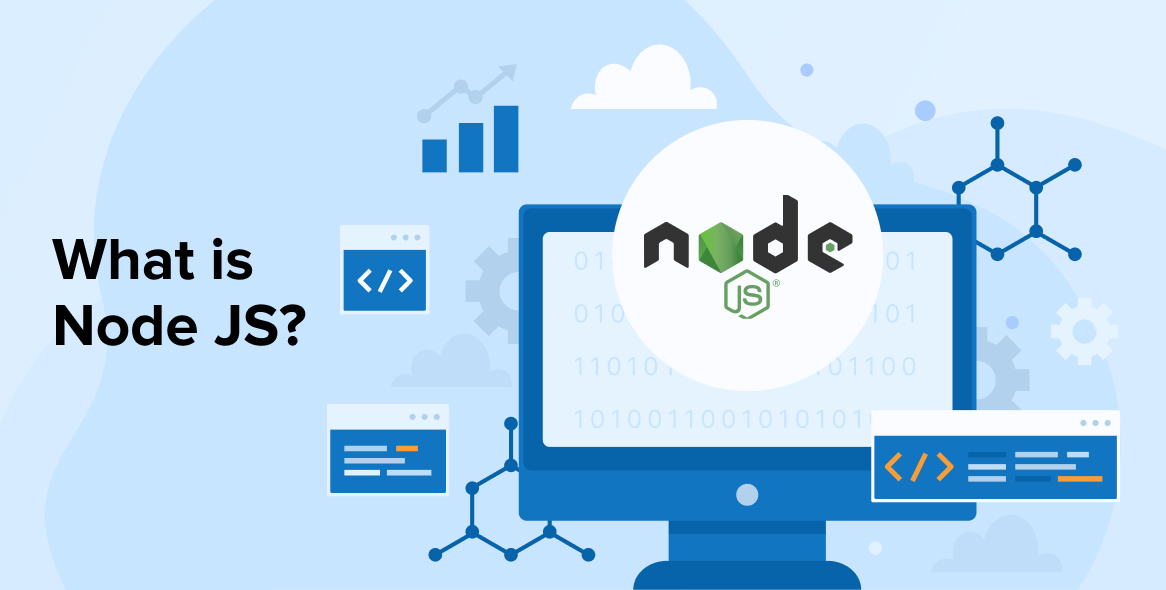
Since the beginning, Golang and Node, which are programming languages utilized for backend development, have been engaged in fierce competition in the software and app development space. Choosing the right language is crucial, as it affects both development speed and application performance. Node.js, known for its event-driven, non-blocking I/O model, excels in handling multiple connections simultaneously. In comparison to NodeJS vs Golang, Golang offers simplicity and strong concurrency support, making it ideal for high-performance applications.
Let’s compare NodeJS vs Golang to determine the best fit for your web development project, focusing on performance, scalability, tools, error handling, and other key factors essential for successful web application development.
1. Overview of Golang
Go is an open-source programming language. This language is a member of the C family; it is a statically typed language, executed, and offers garbage collection. Golang is used for developing highly scalable network applications and is mainly utilized in developing backend server-side applications.

Because it operates on C, the most successful programming language to date, Go is both quick and efficient. The learning curve for Go developers is not steep. Golang has a very basic syntax with only 25 keywords. The language’s excellent usability and simplicity are a result of its clear syntax. So, hundreds or even thousands of engineers working in a huge team can comprehend each other’s code and build and maintain large-scale systems correctly.
Golang, with its seeming simplicity, was built to address the major issues faced by the large organization. Go’s response to the current tech realia is its concurrency support, which is popular for multicore computers running web servers with numerous clients.
One of Golang’s most appealing characteristics, and still is today, is concurrency. To witness the exquisite handling of concurrency in Golang, you may even test out its lightweight threads, and goroutines. The excellent tools available in the Go programming language are well-known.
1.1 What Golang is Used for?
As a general-purpose efficient programming language, Golang may be used to build a wide range of scalable applications, with security- and speed-focused modular application systems.
The most essential things you can do with Golang are build system programming, distributed systems, and servers and apps that can grow to massive sizes. It is also useful for developing web apps, big data, and machine learning applications, as well as for cloud development.
1.2 Advantages of Golang
Let’s see the advantages of Golang.
- Concurrency: Develop highly concurrent and scalable web applications that make use of contemporary multi-core computers with ease using Golang’s integrated concurrency support.
- Performance: Since Golang is turned into machine code, it outperforms interpreted languages such as Node.js in terms of speed. You may easily optimize your apps’ performance with Golang’s built-in measuring and monitoring features.
- Minimalist Syntax: Developers unfamiliar with the language will have little trouble learning and using Golang due to its basic syntax.
- Large Standard Library: Among the many features supported by Golang’s standard library are functions for network programming, encryption, and file I/O. The abundance of third-party libraries for Golang facilitates the rapid development of sophisticated applications.
- Scalability: For developing high-performance, large-scale applications, Golang is an excellent candidate due to its concurrency architecture and memory efficiency.
1.3 Disadvantages of Golang
Now it’s time to analyze the disadvantages of Golang.
- Learning Curve: Although Golang is easy to learn because of its basic syntax, developers unfamiliar with the language may find its concurrency model and error handling complex.
- Garbage Collection: GO utilizes built-in garbage collectors for automatic memory management, but it may also slow things down.
- Limited GUI Support: It may be more challenging to develop desktop apps with complicated user interfaces in Golang due to the language’s poor graphical user interface support in comparison to programming languages like Python or Java.
- Immature Ecosystem: Although Golang’s ecosystem is expanding, the programming language is not yet as developed as Python or Java. Because of this, it may be more challenging to locate developers versed in the language or answers to specific issues.
Now that we’ve covered all the bases with Golang, let’s check out the Node.js framework.
2. Overview of Nodejs
To fulfill the needs of sophisticated, accessible network applications, the open-source community created Node.js, a JavaScript cross-platform runtime environment. You can create complex programs that can operate on Linux, macOS, and Windows with the aid of this environment, which is based on Google Chrome’s V8 JavaScript engine. The fact that NodeJS is based on JavaScript simplifies the process of writing code for both the client and the server side.
Thanks to NodeJS, JavaScript has progressed to the point where it can be used for full-stack development, which includes both the frontend and backend. This further solidifies its position as a top choice among event-driven systems for building web applications.
Also, Node.js is helping a lot of big names in tech speed up their app development processes which we will mention further in this post.
2.1 What NodeJS is Used for?
Whether you’re creating a basic or advanced network application, Node.js is there to help. It works well with programs that deal with networks. Networking applications and server-side environments can both benefit from this JavaScript-based runtime environment.
If you need to build an application that works in real-time, has two-way connections, and doesn’t rely on API returns, Node.js is a great option.
2.2 Advantages of NodeJS
Now let’s review the advantages of NodeJs.
- High Performance: The V8 JavaScript engine is the foundation upon which Node.js and Google Chrome are based. Because of this, it is lightning-quick and can manage massive amounts of traffic without crashing.
- Event-driven and Non-Blocking I/O: Because it employs an event-driven, non-blocking I/O paradigm, Node.js can manage several connections at once without causing the main thread to get blocked. The ability to construct real-time applications, like chat or gaming apps, is what makes it so great.
- Easy to Learn: JavaScript, the leading programming language utilized by Node.js, is popular and simple to pick up and use. This makes it a great fit for programmers who have experience with JavaScript and are looking to create apps on the server side.
- Large and Active Community: An enormous and helpful community of developers works on Node.js and helps out with updates and questions through various web channels.
2.3 Disadvantages of Node.js
Now it’s time to see the disadvantages of Nodejs.
- Difficult to Handle: The Node.js framework is single-threaded, meaning that it processes all requests using just one thread. This has the potential to boost speed, but it may also make blocking I/O activities, such as file I/O or network requests, more difficult to handle.
- NPM Dependency Management: Version conflicts and other installation difficulties are occasionally caused by Node.js’s reliance on NPM (Node Package Manager) for dependency management.
- Callback Hell: Callbacks are essential to Node.js, but they may cause “callback hell”—code that is both complex and difficult to understand.
- Limited Multi-Core Support: The speed of Node.js on multi-core computers can be limited since it is not designed for multi-core processing, even if it can execute several processes.
3. End-to-end Comparison of Golang and NodeJs
Golang is a web development programming language, whereas Node.js provides a more customizable environment for running JavaScript. While Node. Js is a better option for managing small projects, Golang is better suited for large-scale web application development due to its increased dependability and flexibility for building web servers. The best way to decide between Node.js and Golang is to compare and contrast them in a few specific domains mentioned below:
3.1 Performance
When comparing performance and rapidity, Golang is superior. Instead of using an interpreter, Golang is built into machine code. The performance level of Golang is comparable to that of the low-level language C++. As far as IO operations are concerned, Golang is on par with Nodejs.
In terms of performance, Node.js lags behind Golang by a little margin. Although Node.js is a single-threaded framework, its streamlined and enhanced version significantly boosts speed. Without an interpreter, the program can execute thanks to the V8 JavaScript Engine.
3.2 Scalability and Concurrency
When compared to other languages, Go’s method for concurrent programming is novel and innovative. The program efficiently handles parallel communication through the use of “goroutines,” which allows reliable and easy execution & control of threads. This implies that Go makes it easy and natural to execute concurrent tasks, which might otherwise become highly hard.

Here’s an example using goroutines to fetch the same URLs concurrently.
package main import ( "fmt" "net/http" "io/ioutil" ) func fetchUrl(url string, ch chan<- string) { resp, err := http.Get(url) if err != nil { ch <- fmt.Sprintf("Error fetching %s: %s", url, err) return } body, err := ioutil.ReadAll(resp.Body) resp.Body.Close() if err != nil { ch <- fmt.Sprintf("Error reading body from %s: %s", url, err) return } ch <- string(body) } func main() { urls := []string{ "https://jsonplaceholder.typicode.com/posts/1", "https://jsonplaceholder.typicode.com/posts/2", "https://jsonplaceholder.typicode.com/posts/3", } ch := make(chan string) for _, url := range urls { go fetchUrl(url, ch) } for range urls { fmt.Println(<-ch) } } |
Explanation:
- The channel and URL are taken as arguments by the fetchUrl function which we defined in the code above. It executes an HTTP GET request and sends the response body back through the channels
- For communication purposes, it becomes necessary to form a channel and a slice of URLs in the main function.
- Next, we called the go fetchUrl(url, ch) to initiate a goroutine for every URL. It runs the function concurrently.
- In the end, we can read the results for every request from the channel.
There is less elegance in Node.js scalability. Traditionally, event callbacks have been used to execute JavaScript code in concurrent programming. Things may become chaotic very fast. But there are those trying to solve this issue with JS promises and other similar technologies, and they should be able to handle most scenarios. Concurrency in Nodejs is handled using asynchronous functions and event loops. Let’s see an example of making an HTTP request concurrently using Promise.all.
const axios = require('axios'); const urls = [ 'https://jsonplaceholder.typicode.com/posts/1', 'https://jsonplaceholder.typicode.com/posts/2', 'https://jsonplaceholder.typicode.com/posts/3' ]; async function fetchUrls() { try { const requests = urls.map(url => axios.get(url)); const responses = await Promise.all(requests); responses.forEach(response => { console.log(response.data); }); } catch (error) { console.error('Error fetching URLs:', error); } } fetchUrls(); |
Explanation:
- The above code defines an array of URLs we need to fetch.
- With the help of axios.get, the fetchUrls function makes a list of promises for every URL request.
- Execute all the requests concurrently using Promise.all and wait for them to finish before we process the results.
- A request is caught in the catch block in case it fails.
3.3 Error Handling
Most developers should be familiar with Node.js’s error-handling method. Coding errors are captured and managed instantly during runtime using a try-catch error implementation. Here’s a simple example with an explanation in Nodejs.
function divide(a, b) { try { if (b === 0) throw new Error("Division by zero"); return a / b; } catch (error) { console.error("Error occurred:", error.message); } } console.log(divide(10, 2)); // Outputs: 5 console.log(divide(10, 0)); // Outputs: Error occurred: Division by zero |
Explanation:
- Function Definition: The divide function takes two arguments, a and b.
- Try-Catch: After checking b in the try block, we have to throw an error if it is zero.
- Error Handling: The catch block logs a message in the console when it catches the error.
- Output: We can see the right results once we call the function with valid and invalid input.
With Golang, it’s a little bit different. Compilation and runtime error handling are addressed separately in Golang. Let’s take a look at an example in Golang.
package main import ( "errors" "fmt" ) func divide(a, b float64) (float64, error) { if b == 0 { return 0, errors.New("division by zero") } return a / b, nil } func main() { result, err := divide(10, 2) if err != nil { fmt.Println("Error occurred:", err) } else { fmt.Println("Result:", result) } result, err = divide(10, 0) if err != nil { fmt.Println("Error occurred:", err) } else { fmt.Println("Result:", result) } } |
Explanation:
- Function Definition: The divide function returns a float64 result along with an error.
- Error Handling: We use the errors.New() to return the error if b is zero. Otherwise, we have to return the result with nil error.
- Main Function: Call the divide twice. First, with a valid input, and second, with a zero denominator.
- Error Check: Check for errors and print a suitable message after every call.
It is necessary to handle runtime errors explicitly. Most syntax problems that occur during compilation are fixable from inside the code itself.
3.4 Development Tools
All can agree that development time and cost are both reduced when libraries and tools are readily available for any task and project. When referring to development tools, Node.js is at the top of the list. The JavaScript ecosystem has tools for just about every imaginable endeavor, from the simplest to the most complicated.
On its own, NPM has 800,000 case-specific tools, and there are many more that are almost ready for publication but haven’t been released yet. Although there are a lot of excellent tools for handling certain problems in the Golang ecosystem, which is relatively young compared to Node.js, it is still a rather small backend development community.
Given that Node.js applies to both the frontend and the backend, our comparison says that it offers a wider variety of development tools compared to Golang.
3.5 Community
Microsoft, IBM, and Intel all provide grants to the Node.js Foundation. Downloads of Node.js typically surpassed 1 billion in 2018. This exemplifies the rapid expansion of the Nodejs community. The community makes extensive use of Node.js.
The popularity of Golang is growing. Golang has 125k stars on GitHub. There have been 72,424 questions asked on Stack Overflow regarding Golang.

Nodejs has 102k stars on GitHub. In Stack Overflow, 470,833 questions have been asked regarding Node.js.

When it comes to open pull requests, Node.js is ahead of Golang. There are 550 closed pull requests in Node.js and just 485 in Golang. There is a significant gap between the two technologies’ fan bases.
3.6 Learning Curve
The web development framework Node.JS is simple to learn. Lots of excellent, free materials are available online to teach you JavaScript, even if you don’t have much experience with it. The event loop in Node.JS also makes writing concurrent server code a breeze.
Going with Go will need learning a whole new language, with Javascript likely being used for the front end. Companies with more resources and a pressing need for improved performance can justify the expense. Keep to the simple things if you aren’t creating something similar.
3.7 Finding Developers
The market fails to deliver experienced NodeJS developers as needed. However, their number is far more than that of Golang developers. The reason is, that dedicated developers with experience in NodeJS are far simpler to get by than JavaScript programmers, yet JavaScript is a widely used programming language. You can also train your programmers to juggle several projects with ease.
There aren’t many Golang developers, and it’s hard to discover them as the language is still in its infancy. People are picking it up at their own speed, and supply will eventually catch up to demand.
3.8 Major Tech Players Using Go and Node.js
This section informs you about the big tech companies using Go and NodeJS. It also gives an example for each technology and explains how it is empowering global brands.
3.8.1 Go
Top brands like BBC, Basecamp, Docker, Google, Heroku, Intel, Medium, and Uber are using Go for their platforms. Let’s talk about how Uber does it. Initially, the company was using NodeJs but once Go was released, Uber decided to shift to Go.
The reason behind taking this decision was their geofence lookup microservice. Uber has the most queries per second for this microservice. They needed their geofence to be updated so they had to gather the latest information from multiple sources simultaneously.
The single-threaded nature of NodeJS was inefficient in doing this task and hence, slowing down the application with it. But with the Goroutines from Go, the Uber app gets parallel execution resulting in increased speed and performance.
3.8.2 Node.js
Tech companies like Netflix, Paypal, Walmart, Linkedin, eBay, and Trello are leveraging NodeJS to build and maintain their platforms. For example, Netflix built the entire UI of its app using NodeJS. Their app is fast and lightweight because of NodeJS. It has helped them reduce the app startup time by 70%.
Anyone can look up and say so and so companies are using such technologies. But the reason why we discussed the “how” is because it shows how Go and Nodejs can fulfill your real-world requirements.
Businesses are embracing cutting-edge tech to stay up with the ever-shifting business landscape, which demands lightning-fast speed and top-notch quality. Examining the brands that choose to create backend solutions after comparing Node.js and Golang, we can now discover which one is more widely recognized.
Businesses employing Go:
- Netflix
- eBay
- Trello
- PayPal
Businesses employing Node.js:
- Uber
- BBC
- Medium
- Intel
4. NodeJS vs Golang: The Verdict
Both Golang and Node.js are robust technologies, yet they each have their own set of advantages and disadvantages. Compared to Node.js, which is more suited to I/O-bound operations and has a bigger library of third-party modules, Golang provides great performance for CPU-bound work and includes built-in concurrency capabilities.
Your project’s requirements and the skill level of your team should guide your decision between Golang and Node.js. To design high-quality apps that suit your demands, it is important to understand the advantages and disadvantages of each technology. This will help you make an informed selection.
FAQ
Which do you prefer, Node.js or Golang? Why?
It depends on your preference, if you’re looking for superior speed, security, and scalability then Go is the preferable choice. Go includes features like the Race Condition Detector and offers robust error-handling capabilities. Although Node.js efficiently manages errors and provides an extensive toolkit for developers, it may not meet the high-speed requirements of today’s industry as effectively as Go.
Is Golang faster than NodeJS?
Ans: When it comes to speed then Go will outrank Nodejs because it is capable of handling up to a thousand queries simultaneously. It is because of its lightweight design and its foundation in C and C++. Conversely, Node.js, while dynamic and versatile due to its JavaScript ancestry, may not match Go’s performance in high-concurrency scenarios. However, Node.js’s ecosystem and the non-blocking I/O model still make it a strong contender for many web development projects.






Comments
Leave a message...